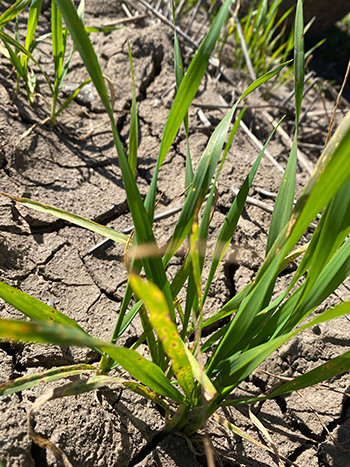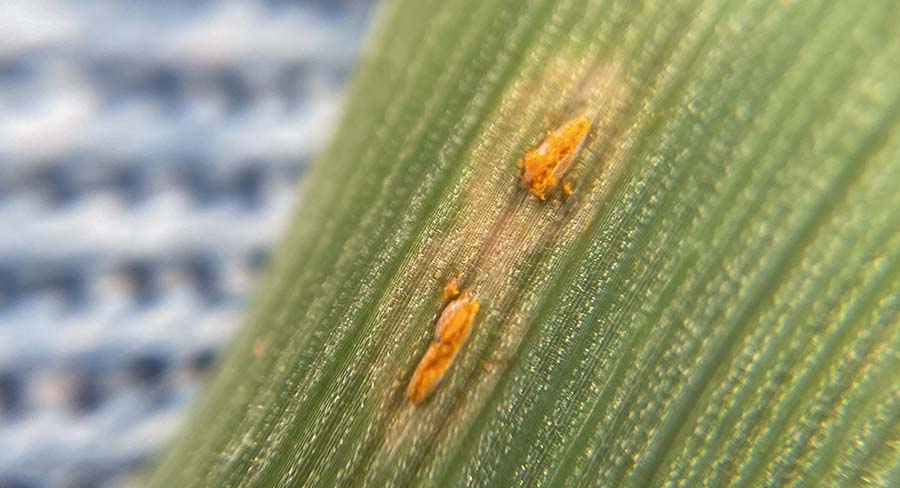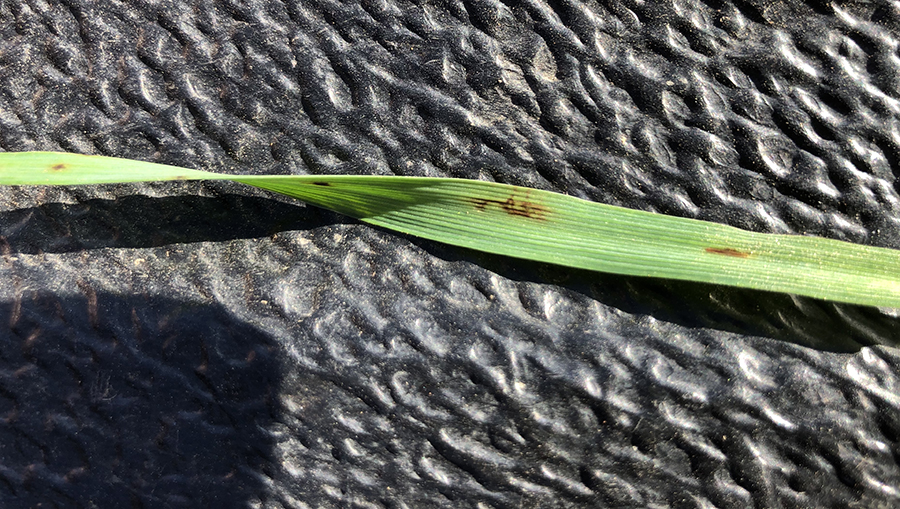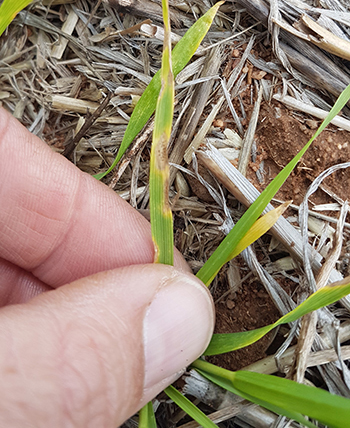Six agronomists from across Australia share how their clients are working to protect their crops against stripe rust and other cereal diseases based on what they have experienced in the past couple of years. We will follow their journey across the season with regular updates
Paul Castor, Queensland

Independent agronomist Paul Castor is based in Toowoomba, Queensland. He services growers on the Darling Downs and Western Downs. He is a director of MCA Agronomy, which also has bases in Chinchilla and Goondiwindi. His comments include feedback from this group, which has clients from Narrabri in northern New South Wales, north-west to Roma, Queensland, and north-east to Pittsworth, Queensland.
Season 2020 was overall a relatively quiet year for cereal diseases among our clients, although we did have some challenges in managing the new 198 stripe rust pathotype in durum varieties. However, in 2021, as for most grain growing regions, we had significant and widespread infections of stripe rust. This started early in the very odd crop of DS Bennett grazing wheat and then ramped up throughout the wet and mild spring.
Our longer-growing-season districts (further south and east) were where the disease needed stronger management. In these districts, multiple fungicide applications were applied to most moderately resistant to moderately susceptible (MRMS) or worse varieties.
Even varieties with better stripe rust resistance ratings such as LRPB Lancer (RMR) had worrying levels of infection in some cases before the adult plant resistance genes became active later in crop development.
While most disease was managed with well-timed foliar fungicides during 2021, we did have some fungicide timing issues on varieties such as Coolah, which were reacting far worse to stripe rust infection than their MR rating (in 2021) would have suggested.
Following very wet summer and autumn conditions, along with the forecast of another wetter-than-average winter cropping season, stripe rust has a high probability of being a threat to crops again this year.
Growers are generally well prepared to manage this threat, with only a limited area of varieties rated MRMS or worse for stripe rust planted. These crops will have access to fungicides for a two-spray program again this season.
Of some concern is the fact that the extremely wet summer and autumn did not favour total green bridge management. Difficult-to-manage volunteer wheat in several double-cropped sorghum paddocks was an extreme example of this issue.
Nonetheless, we are yet to find any stripe rust in wheat crops this season. We have, however, had one Sunmax crop sampled with rust infection, which is most likely to be leaf rust. This has been sent to the University of Sydney for confirmation. Crown rust in oat crops is common.
 Yellow leaf spot in wheat. Photo: MCA Agronomy.
Yellow leaf spot in wheat. Photo: MCA Agronomy.
The greater concern in 2022 is the increased level of wheat-on-wheat plantings driven by poor marketing prospects for chickpeas.
We already have yellow leaf spot infections in several early sown paddocks in 2021 wheat stubble.
Yellow leaf spot is not a disease that needs regular fungicide management in our region, with only the very wet years of 1998 and 2010 having widespread damaging infections. This makes fungicide forecasting for this disease very difficult.
Thankfully, we have large areas planted to varieties with some useful levels of yellow leaf spot resistance.
We also had very few paddocks planted early into wheat stubble from 2021 and the dry spell through June has prevented yellow leaf spot infection on later planted crops at this stage.
Net blotch (both net and spot form) in barley is again very easy to find this season. This aggressive disease of barley will likely need fungicide intervention in most commonly grown barley varieties again this season as at best they only have moderate levels of resistance to these diseases.
Rob Holmes, northern New South Wales

Moree, NSW, independent agronomist Rob Holmes has clients who run irrigated and dryland farming systems incorporating winter and summer cropping.
Stripe rust was insignificant for most growers during the past two years.
This may be because there was widespread use of preventive fungicide treatment at the four to five-leaf stage to keep the disease in check.
There was more rust prevalent in durum varieties and some of the older ‘Sun’ types such as Suntop and Sunvale.
Over summer and autumn, most growers aimed to spray their paddocks to control weeds and volunteer wheat plants to preserve subsoil moisture.
Accordingly, the green bridge that allows the stripe rust pathogen to survive from one season to the next is rarely an issue.
However, this season, due to flooding and untimely rain, growers are still planting their crops.
The flooding and wet weather hindered weed control in many places and consequently, a green bridge of volunteer wheat plants from harvest 2021 has elevated stripe rust risk this season.
All growers aim to choose varieties with the highest level of stripe rust resistance.

Crown rust in oats. Photo: Rob Holmes
All have budgeted to apply one fungicide at the four to five-leaf stage and most have factored in a second treatment during August for any varieties that are moderately susceptible to stripe rust (such as durum wheat).
While we have not yet seen any stripe rust, we are expecting to see it soon.
We saw crown rust in oats during summer, autumn and winter. We have seen symptoms that look like stem rust and leaf rust (crown rust) in oats and these samples have been sent to the University of Sydney Australian Cereal Rust Survey for diagnosis.
Emma Robinson, southern NSW
Stripe rust was a managed risk at Temora in 2020. Growers managed it proactively by treating fertiliser with fungicide and ensuring crops were sprayed with a foliar fungicide at the correct time.

At Temora, in the south-west slopes region of NSW, agronomist Emma Robinson provides advice to growers cultivating winter crops. She works for Nutrien Ag Solutions.
In 2021, both Septoria and stripe rust were risks. Plans were made to manage both diseases with flutriafol (Impact) and Z31 and flag leaf (Z39) foliar fungicide. These plans were mainly carried out. However, north of Temora, heavy falls of rain prevented some growers applying the first application of foliar fungicide, as paddocks were too wet and aeroplanes were not readily available.
Accordingly, the treatments that were applied at flag emergence or later ran out of puff a bit faster than they would have normally. This was because there was such high disease pressure and the foliar fungicides had to work harder to control the diseases and ran out of protection. Plenty of very late applications of high-end fungicide products were then applied, which – with a long and soft spring – bumped yields significantly.
Growers took a proactive approach to destroy the green bridge over the summer by terminating cereal volunteers and weeds. Generally, three sprays were applied over the summer and autumn, on average, to destroy the green bridge.
 Rust in wild oats. Photo: Emma Robinson
Rust in wild oats. Photo: Emma Robinson
This year, the weather was so wet that growers could not traffic their paddocks and sow wheat crops on time. Plans made in 2021 to grow varieties with resistance to stripe rust such as LRPB Lancer had to be shelved as the available sowing time was not appropriate.
More than 80 per cent of my clients have sown Scepter, Catapult and Vixen, which are all susceptible to stripe rust. The remainder was sown to Illabo and Beckom, which have improved levels of stripe rust resistance.
All growers have applied fungicide to their fertiliser with the aim of protecting crops through to elongation before foliar fungicides are required.
Although most clients have yet to order their fungicide supplies, we have made sure there will be enough stock available.
We have not seen any stripe rust yet as most of the wheat was planted later in the sowing window. I have seen Septoria around, but that is not unusual.
We will need to keep an eye out for Septoria and stripe rust but will stick to our plans of managing these diseases proactively, provided paddocks dry out in time for spraying.
John Stuchbery, Victoria

John Stuchbery is an independent agronomist based at Donald, Victoria. He services growers cultivating winter crops in the Wimmera’s medium-rainfall zone.
Stripe rust was not a huge issue during the past two years among our clients; however, we did see a lot of Septoria due to the wet winter.
Most growers were proactive in their use of foliar fungicides, and this worked well to keep the disease at bay.
Everybody was focused on controlling volunteers over the summer and autumn, and this will have reduced the carryover of rust pathogens from last season to this season.
Seasonal breaking rains arrived during mid-April, so we are expecting the disease risk to be high this year.
Growers are aware of the emergence of new pathotypes of stripe rust in the past 12 months. They have been keen to select wheat varieties with higher levels of resistance. Growers have also been bulking-up Maximus barley to replace Spartacus CL barley, partly because it has improved resistance to the net blotch diseases.

Net form of net blotch in three-leaf Spartacus barley. Photo: John Stuchbery.
Many growers rely on preventive foliar fungicides if they have planted stripe rust susceptible wheat varieties or disease-susceptible barley varieties.
So far, we have not yet seen any stripe rust, but we have seen spot form of net blotch and net form of net blotch in barley.
Jeff Braun, South Australia
 Independent agronomist Jeff Braun with his son Zac.
Independent agronomist Jeff Braun with his son Zac.
Independent consultant Jeff Braun services growers on South Australia’s Yorke Peninsula, the mid-north and Mallee. His clients’ median annual rainfall ranges from 250 millimetres to 600mm.
During 2020, many growers were still growing LRPB Trojanwheat and we saw some stripe rust in that variety.
As the 198 pathotype of stripe rust became more abundant, many growers switched away from LRPB Trojan, which has a susceptible to very susceptible (SVS) rating.
Most selected Rockstar as their replacement, which carries a moderately resistant (MR) rating to the 198 pathotype.
Given Rockstar is susceptible to the 239 pathotype of stripe rust, it still requires proactive disease management.
Some of the areas I work in have later emerging crops due to the delay in opening rains. The cold conditions since then have generally limited the rate of disease development.
 Septoria tritici in Scepter (PBR) wheat. Photo: Jeff Braun
Septoria tritici in Scepter (PBR) wheat. Photo: Jeff Braun
Generally, in South Australia, early sown or warmer climate areas have provided an early warning system if stripe rust or other diseases are prevalent.
Most growers have kept fallows free of volunteers during summer and autumn, which should limit the carryover of stripe rust from last season’s crops on to this season’s crops.
Most of my clients have budgeted to proactively apply fungicides for Septoria and eyespot, which will also be effective on stripe rust.
Many have fungicide left in the shed that was not used last year because spring conditions turned dry.
We have not seen any stripe rust symptoms yet this season because conditions have been too cold.
We have seen a small amount of yellow leaf spot and early Septoria where wheat was planted after wheat.
My clients generally do not plant wheat after wheat but this year a number have taken the opportunity to do this because of high wheat prices.
We have also seen a small amount of net blotch in barley near the Victorian border, where crops were planted early.
Trent Butcher, Western Australia
 ConsultAg research agronomist Trent Butcher.
ConsultAg research agronomist Trent Butcher.
Independent research agronomist Trent Butcher is based at Narrogin, Western Australia. He provides advice to mixed farmers and continuous croppers from west of Narrogin to Lake King in the eastern grain belt. His clients mainly grow barley because of wheat’s increased susceptibility to frost.
After seven years working in agronomy, I have never seen stripe rust in the paddock.
Since growers have been growing Mace and Scepter, we have not had an issue with stripe rust.
There were reports of isolated cases of stripe rust in Chief CL Plus and Calingiri near Narembeen and Merredin during 2021 but, beyond that, I have not heard of a case of stripe rust in WA since 2016.
Note: WA at present only has the older 134 pathotype of stripe rust and has not been exposed to more recent exotic incursions from the 198 and 239 pathotypes of stripe rust which have become dominant in eastern states since 2020. This also highlights the importance of biosecurity when travelling to WA to avoid the introduction of these stripe rust pathotypes from eastern Australia on clothing. Rust spores can be blown long distances, which has seen the spread of these pathotypes over time across the eastern states. But wind currents generally provide a barrier to spore movement from eastern Australia to WA.
In 2021, there was a big issue with crown (leaf) and stem rust in oats. Leaf rust is normally the biggest issue in oats and Bannister (PBR), our main oat variety, is widely grown as it has shown handy resistance to leaf rust. However, in 2021, stem rust was common. The moderately susceptible (MS) rating of Bannister meant it was hit hard. Wandering, is an older oat variety but it is still commonly grown. It has lower rust resistance across the board, and consequently had significant infections of both stem and crown rust in 2021.
 Septoria in oats. Photo: Trent Butcher
Septoria in oats. Photo: Trent Butcher
One of the reasons for high levels of rust in oat crops was the presence of a green bridge that allowed the pathogen to carry over from season 2020 to 2021. Traditionally, our main management tool for rusts has been volunteer control to rid farms of the green bridge.
A large outbreak of powdery mildew in wheat a few years ago saw growers increase their use of in-furrow fungicide. Many growers have continued their use of in-furrow fungicide to this day.
Our leading wheat varieties for yield are also the best for stripe rust resistance. Accordingly, most growers tend not to apply preventive foliar fungicides to their wheat.
Last year was the first year many applied preventive fungicides to their wheat; however, this was to manage Septoria.
We have not seen any rust yet this season, though we are seeing spot form of net blotch in barley and Septoria in oats. Consequently, as fungicides are applied to manage these diseases, any rust is likely to also be controlled.

























































